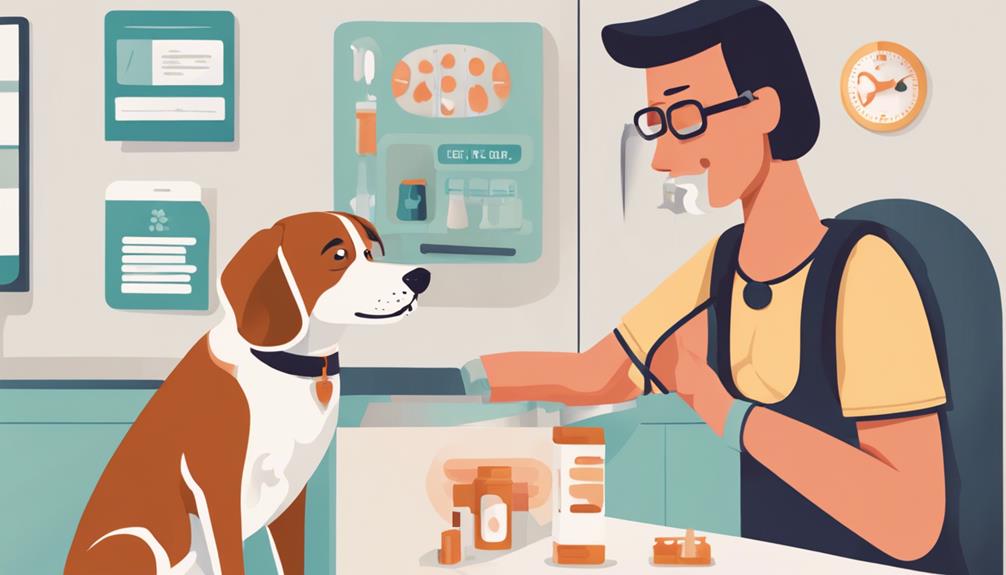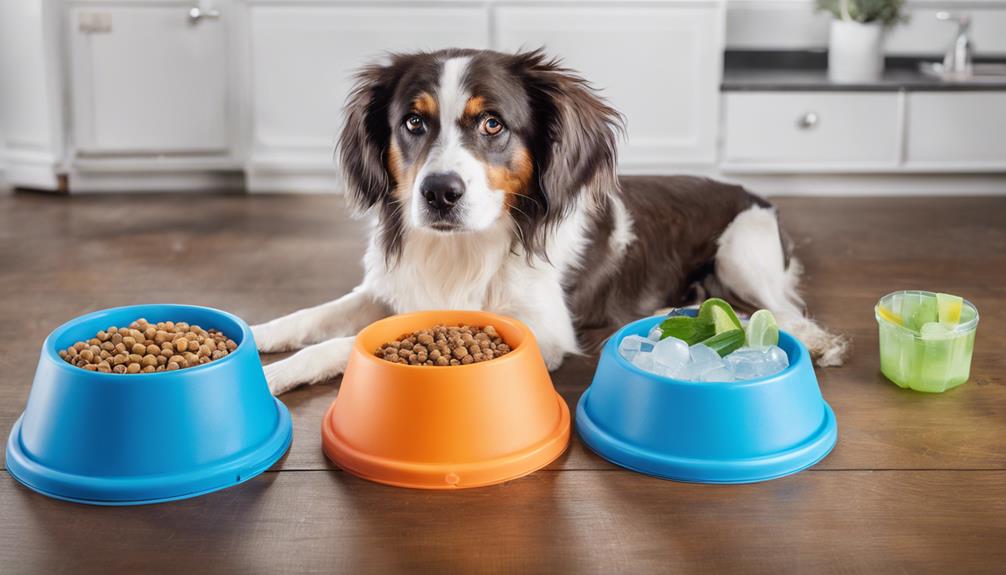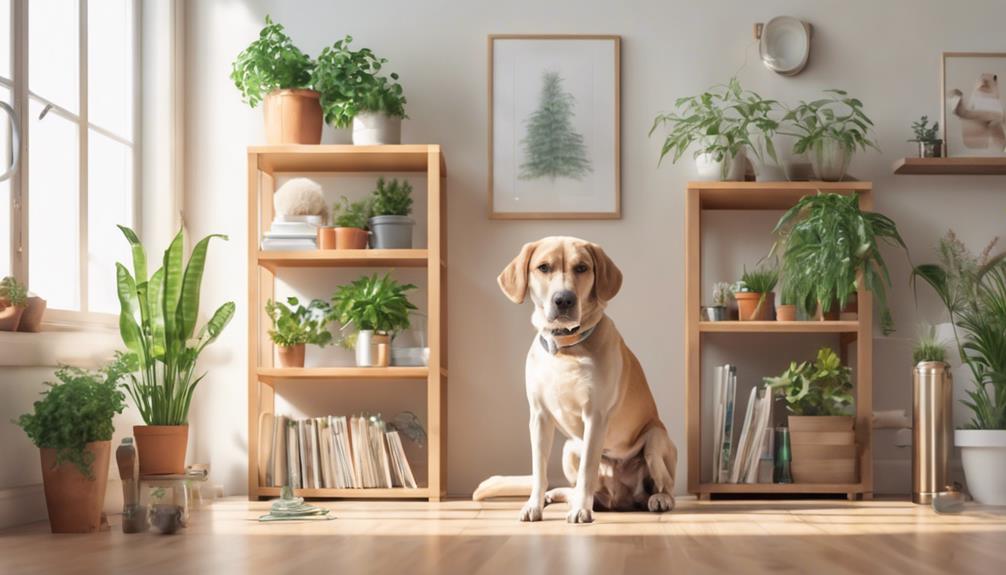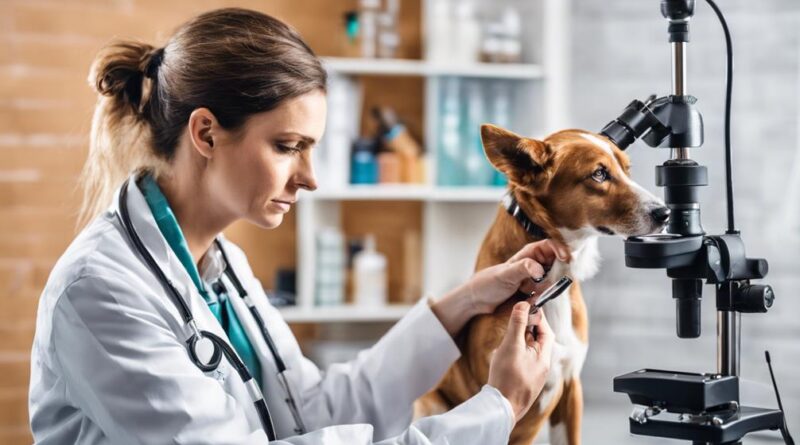15 Tips to Navigate Dog Eye Diseases Successfully
To navigate dog eye diseases successfully, watch for redness, excessive tearing, and cloudiness. Regular eye exams are crucial for spotting issues early. Learn about common conditions like cataracts and glaucoma, explore treatment options. A balanced diet with essential nutrients can prevent diseases. Avoid irritants to reduce risks. Keep the eye area clean through grooming and gentle wiping. Hydration and sun protection are essential. Ensure a safe environment for your pet's well-being. These tips can positively impact your dog's ocular health. Additional insights on care practices await for enhanced eye disease management.
Recognizing Symptoms Early
To catch dog eye diseases early, pay close attention to any changes in your pet's eyes such as redness, excessive tearing, or cloudiness. Early detection is key in successfully managing these conditions. If you notice any of these symptoms, it's crucial to consult your veterinarian promptly for proper diagnosis and treatment options.
Symptoms such as redness may indicate inflammation or infection, while excessive tearing could be a sign of allergies, injury, or a blocked tear duct. Cloudiness in the eye may suggest cataracts or other more serious issues. Timely intervention can help prevent further progression of the disease and improve outcomes for your furry friend.
In terms of treatment options, your veterinarian may recommend medications, eye drops, or surgical procedures depending on the specific condition affecting your dog's eyes. Proper management of symptoms is essential to alleviate discomfort and prevent complications. Additionally, your vet may suggest prevention strategies to minimize the risk of recurrent eye problems in the future.
Regular Eye Exams
Regular eye exams for your dog are crucial in maintaining their ocular health and detecting any potential issues early on. Just like with humans, prevention is key when it comes to eye diseases in dogs. By scheduling regular check-ups with your veterinarian, you can help prevent serious eye conditions from developing or worsening. These exams play a vital role in ensuring your furry friend's vision and overall eye health are in top condition.
Early detection techniques used during these eye exams are essential for identifying any underlying problems before they progress. Your veterinarian will conduct a thorough examination of your dog's eyes, checking for signs of diseases such as cataracts, glaucoma, or infections. Through these exams, issues can be caught early, allowing for prompt treatment and better outcomes.
Understanding Common Conditions
Understanding common eye conditions in dogs is essential for proactive care and early intervention to maintain their ocular health. Dogs, like humans, can experience various eye ailments that may require specific diagnosis and treatment options. Here are some key common conditions to be aware of:
- Cataracts: This condition involves clouding of the lens in the eye, leading to vision impairment. Cataracts can be genetic, age-related, or caused by an underlying health issue. Diagnosis involves a thorough eye examination by a veterinarian, and treatment options may include surgery to remove the cataract and restore vision.
- Conjunctivitis: Also known as pink eye, conjunctivitis is the inflammation of the conjunctiva, the clear membrane covering the white part of the eye. It can be caused by allergies, infections, or irritants. Understanding the diagnosis involves identifying the underlying cause through a vet examination. Treatment options may include eye drops, ointments, or oral medications.
- Glaucoma: Glaucoma is a condition where there's increased pressure within the eye, leading to damage of the optic nerve and potential vision loss. Diagnosis includes measuring the intraocular pressure and assessing the optic nerve. Treatment options may involve eye drops, oral medications, or surgery to manage the condition and prevent further damage.
Importance of Proper Nutrition
Proper nutrition plays a pivotal role in maintaining the overall health and well-being of your dog, including their ocular health. Providing your furry friend with a balanced diet is essential to support their immune system, overall body function, and eye health. A diet rich in essential nutrients such as vitamins A, C, and E, as well as omega-3 fatty acids, can help prevent eye diseases and maintain optimal vision.
In addition to a balanced diet, nutritional supplements can also play a crucial role in supporting your dog's eye health. Supplements containing antioxidants like lutein and zeaxanthin can help protect the eyes from damage caused by free radicals and reduce the risk of age-related eye conditions.
When choosing food for your dog, opt for high-quality, reputable brands that offer complete and balanced nutrition. Look for products specifically formulated to support eye health or consult with your veterinarian for recommendations tailored to your dog's individual needs.
Avoiding Irritants
To protect your dog's eyes from potential harm, it's important to be mindful of avoiding irritants in their environment. Dogs are susceptible to various eye irritants that can lead to discomfort and potential eye diseases. Here are some essential tips to help you keep your furry friend's eyes safe:
- Avoiding pollutants: Just like humans, dogs can also suffer from the effects of pollutants in the environment. Make sure to keep your dog away from areas with heavy traffic or industrial activities to minimize their exposure to harmful substances.
- Proper ventilation: Ensure that the areas where your dog spends time are well-ventilated. Proper airflow helps in reducing the concentration of irritants in the air, promoting better eye health for your canine companion.
- Using eye protection: When taking your dog out for activities like swimming or in dusty environments, consider using doggy goggles to shield their eyes from debris and harmful particles.
In addition to these measures, limiting your dog's screen time can also be beneficial. Just like prolonged screen exposure can strain human eyes, excessive exposure to screens can also lead to eye irritation in dogs. By being proactive and mindful of these factors, you can significantly reduce the risk of eye irritations and diseases in your beloved pet.
Keeping the Eye Area Clean
Ensuring your dog's eye area stays clean is crucial for preventing potential eye infections and maintaining good eye health. Proper grooming plays a significant role in keeping the eye area clean. Regularly trim the fur around your dog's eyes to prevent it from obstructing vision or causing irritation. Use a clean, damp cloth to gently wipe around the eyes, removing any discharge or dirt. Avoid using harsh chemicals or soaps near the eyes, as they can cause irritation and lead to eye problems.
In addition to proper grooming, gentle handling is essential when cleaning your dog's eye area. Be patient and calm to ensure your dog feels comfortable during the cleaning process. Hold your dog's head steady but not too firmly, and avoid putting pressure on the eye itself. Use a light touch when wiping around the eyes to prevent any discomfort or injury.
Regularly inspect your dog's eyes for any signs of redness, swelling, or discharge. If you notice any abnormalities, consult your veterinarian for further evaluation. By maintaining a clean eye area through proper grooming and gentle handling, you can help reduce the risk of eye infections and promote good eye health in your furry companion.
Providing Adequate Rest

Maintaining a healthy routine of providing adequate rest for your dog is fundamental in promoting overall well-being, including eye health. Just like humans, dogs need proper rest to recharge and maintain optimal health.
Here are some tips to ensure your furry friend gets the rest they need:
- Relaxation Techniques: Introducing relaxation techniques can help your dog unwind and de-stress, promoting better sleep quality. Consider gentle massages or calming music to create a soothing environment.
- Sleep Schedule: Establishing a consistent sleep schedule for your dog can regulate their body clock, ensuring they get enough rest each day. Try to stick to regular bedtime and wake-up times to support a healthy sleep routine.
- Comfortable Bedding, Quiet Environment: Providing your dog with a comfortable bed and a quiet place to sleep is essential for promoting restful sleep. Ensure their bedding is cozy and placed in a peaceful area free from loud noises or distractions.
Managing Stress Levels
Promoting a stress-free environment for your dog is crucial in managing their overall well-being and eye health. Dogs, like humans, can experience stress, which may impact their eye health. To help your furry friend stay calm and healthy, consider implementing stress management techniques and relaxation exercises into their routine.
One effective way to reduce your dog's stress levels is through mindfulness practices. Engaging in activities that promote mindfulness can help your dog relax and alleviate any tension they may be feeling. Additionally, practicing meditation with your dog can have numerous benefits, including reducing anxiety and promoting a sense of calmness.
Creating a peaceful environment at home is essential for your dog's well-being. Ensure that your dog has a comfortable and quiet space where they can retreat when feeling overwhelmed. Providing them with their own safe haven can help lower their stress levels and contribute to better eye health.
Regular exercise is another excellent way to manage your dog's stress. Physical activity not only keeps your dog healthy but also releases endorphins that can improve their mood. Whether it's a daily walk, a game of fetch, or some interactive playtime, keeping your dog active is key to reducing their stress levels and maintaining good eye health.
Seeking Veterinary Care Promptly

Seek veterinary care promptly when you notice any changes or abnormalities in your dog's eyes to ensure timely diagnosis and treatment. Early intervention is crucial in managing dog eye diseases effectively. Here's why seeking veterinary care promptly is essential:
- Timely Diagnosis: Getting your dog to the vet early allows for swift identification of any eye issues. Early detection can lead to more effective treatment plans and better outcomes for your furry friend.
- Prevent Progression: Some eye diseases can progress rapidly if left untreated. Seeking veterinary care promptly can help prevent the worsening of the condition and potential complications.
- Veterinary Expertise: Veterinarians have the training and knowledge to accurately diagnose and treat a variety of eye conditions in dogs. Their expertise is invaluable in ensuring the best possible care for your pet.
Following Treatment Plans Diligently
Adhering to your dog's treatment plan diligently is crucial for effectively managing and improving their eye condition. Following the prescribed medication schedule, attending follow-up appointments, and making any necessary lifestyle adjustments are key components of ensuring your furry friend receives the best care possible.
Compliance challenges may arise when administering medications or carrying out treatment procedures. It's important to stay organized by setting reminders, creating a routine, and seeking support from family members or friends if needed. Your veterinarian can also provide valuable tips to help you overcome any obstacles you may face.
Support systems play a significant role in helping you stay on track with your dog's treatment plan. Whether it's through online communities, support groups, or simply leaning on loved ones for emotional support, having a strong support system can make a world of difference during this challenging time.
In some cases, lifestyle adjustments may be necessary to accommodate your dog's treatment plan. This could include changes in diet, exercise routines, or daily activities. By making these adjustments and incorporating them seamlessly into your daily life, you can ensure your dog is getting the comprehensive care they need.
Monitoring Progress Closely

To closely monitor your dog's progress with their eye disease, regularly observe any changes in their symptoms and behavior. Keeping a keen eye on how your furry companion is responding to treatment is crucial for their recovery.
Here are some key points to consider:
- Progress Monitoring: Track any improvements or worsening of your dog's eye condition. Note down any changes in redness, discharge, cloudiness, or changes in their vision. This information will help you and your vet evaluate the effectiveness of the current treatment plan.
- Treatment Adjustments: If you notice any concerning developments or lack of improvement, communicate promptly with your vet. They may need to adjust the medications, dosages, or treatment methods to better address your dog's specific needs. Being proactive in addressing changes can lead to better outcomes for your pet.
- Communication, Vet Collaboration: Establish open communication with your vet to discuss your observations and any questions you may have. Your vet is there to support you and your dog through this process. Collaboration between you and the veterinary team is essential for devising the most effective treatment plan and ensuring your dog's eye health is managed optimally.
Preventing Infections
To prevent infections in your dog's eyes, implementing good hygiene practices and regular check-ups are essential. Keeping your dog's living areas clean, including their bedding and toys, can help prevent accidents that may lead to eye infections. Wiping your dog's face gently with a damp cloth can also help remove any dirt or debris that could cause irritation or infections. Additionally, it's crucial to avoid using harsh chemicals or products near your dog's eyes that could potentially lead to irritation or infections.
Promoting wellness in your dog is another key aspect of preventing eye infections. Ensuring your dog receives a balanced diet rich in essential nutrients can help boost their immune system and overall health, reducing the likelihood of infections. Regular exercise can also contribute to your dog's wellness by maintaining their overall health and preventing obesity, which can lead to various health issues, including eye infections.
Moreover, scheduling regular check-ups with your veterinarian is crucial for preventing infections in your dog's eyes. Your vet can detect any potential issues early on and provide appropriate treatment to prevent infections from developing. By following these preventive measures and promoting your dog's wellness, you can help keep their eyes healthy and reduce the risk of infections.
Ensuring Proper Hydration

Ensuring your dog stays properly hydrated is crucial for maintaining their overall health and preventing potential eye issues. Adequate hydration benefits your furry friend in numerous ways, including promoting proper bodily functions, aiding digestion, and supporting overall well-being.
When it comes to water intake for your dog, here are a few essential tips to keep in mind:
- Provide Access to Fresh Water: Always ensure your dog has access to clean and fresh water throughout the day. Monitor their water bowl to make sure it's refilled regularly, especially during hot weather or after physical activity.
- Consider Wet Food: Wet dog food contains higher water content compared to dry kibble, which can contribute to your dog's overall hydration. Adding some wet food to their diet can be a good way to increase their water intake.
- Use Hydration Monitoring Techniques: To ensure your dog is properly hydrated, you can observe their behavior and check for signs like pale gums, lethargy, or dry skin. If you suspect dehydration, consult your veterinarian promptly.
Minimizing Sun Exposure
Keeping your dog safe from harmful UV rays requires proactive measures to minimize sun exposure. Just like humans, dogs are susceptible to sun damage, particularly in their sensitive eye area. To protect your furry friend, consider using protective eyewear or sunglasses specifically designed for dogs when they're outdoors. These items can help shield your pet's eyes from the sun's harsh rays and reduce the risk of eye diseases caused by excessive exposure.
Additionally, providing ample shade in your outdoor space is crucial in minimizing your dog's sun exposure. Whether it's setting up a canopy, utilizing trees for natural shade, or creating a sheltered area with a dog house, ensuring your pet has a cool and shaded spot to rest during sunny days can significantly decrease the time they spend in direct sunlight.
If your dog is going to be out in the sun for an extended period, you may also want to consider applying pet-safe sunscreen around their eyes. Just like humans, dogs can benefit from the protection that sunscreen provides against harmful UV rays. Make sure to choose a sunscreen that's specifically formulated for dogs and avoid products that contain zinc oxide, as it can be toxic to pets if ingested.
Creating a Safe Environment

For a safe environment for your dog, assess your living space for potential hazards and make necessary adjustments to prevent accidents or injuries. Dogs are curious animals, and creating a safe environment is crucial to their well-being.
Here are some tips to help you ensure a safe space for your furry friend:
- Secure Hazardous Areas: Identify areas in your home where your dog could potentially get hurt, such as steep staircases or rooms with toxic plants, and take measures to block access to these areas.
- Remove Small Choking Hazards: Dogs, especially puppies, tend to explore the world with their mouths. Keep small objects like toys, coins, or batteries out of reach to prevent choking incidents.
- Supervise Playtime: Engage in safe play with your dog and supervise their interactions with toys to prevent any accidents. Avoid toys that are small enough to be swallowed or that have small parts that could be chewed off.
Creating a safe environment isn't only about physical space but also about engaging in supervised activities that promote your dog's well-being and prevent potential injuries. By taking these precautions and actively monitoring your dog's surroundings, you can provide a secure and enjoyable environment for your furry companion to thrive in.
Frequently Asked Questions
How Can I Help My Dog Adjust to Wearing Protective Eyewear?
When helping your dog adjust to protective eyewear, start by incorporating positive reinforcement during short training sessions. Begin with short intervals of wearing the eyewear and gradually increase the duration.
Ensure the eyewear fits comfortably and doesn't cause any discomfort. Use treats and praise to reward good behavior and help your dog associate the eyewear with positive experiences.
With patience and consistent training techniques, your dog will adapt to wearing protective eyewear successfully.
Are There Any Specific Exercises to Strengthen My Dog's Eye Muscles?
To improve your dog's eye health and strengthen their eye muscles, you can engage them in activities that promote focus and tracking. Playing games like fetch with brightly colored toys or using puzzle toys that require visual problem-solving can help.
Additionally, incorporating short training sessions that involve visual cues can also be beneficial. Regular exercise and mental stimulation are key to maintaining your dog's eye health and muscle strength.
What Alternative Therapies Can Complement Traditional Treatments for Dog Eye Diseases?
To complement traditional treatments for dog eye diseases, consider alternative therapies like acupuncture therapy, herbal remedies, nutritional supplements, and laser therapy. These methods can provide additional support and promote healing in conjunction with conventional veterinary care.
Acupuncture therapy may help improve blood flow and reduce inflammation, while herbal remedies could offer natural soothing properties. Nutritional supplements can enhance eye health, and laser therapy may aid in tissue repair and pain management.
Can Emotional Support Animals Assist Dogs With Visual Impairments?
When your dog experiences visual impairment, having an emotional support animal can be incredibly beneficial.
Animal therapy, especially with canine companions, can provide comfort, companionship, and a sense of security to your visually impaired dog.
The presence of another animal can help reduce anxiety and stress, improving your dog's overall well-being.
This emotional support can make a significant difference in your dog's quality of life as they navigate their visual challenges.
How Can I Prevent My Dog From Rubbing Their Eyes Excessively During Treatment?
To prevent your dog from rubbing their eyes excessively during treatment, try addressing dog anxiety first. Introduce eye drops gradually, using positive reinforcement and rewards.
Implement behavioral training techniques to discourage eye rubbing. Engage your dog with distractions like toys or treats to redirect their focus.
Consistency and patience are key in helping your dog adjust to the treatment and reduce the urge to rub their eyes.
Conclusion
In conclusion, by following these tips and being proactive in caring for your dog's eyes, you can successfully navigate dog eye diseases. Remember to stay vigilant for any symptoms, schedule regular eye exams, provide proper nutrition, avoid irritants, prevent infections, keep your dog hydrated, minimize sun exposure, and create a safe environment.
Your furry friend's eye health is crucial, so take the necessary steps to ensure they have the best possible care.
